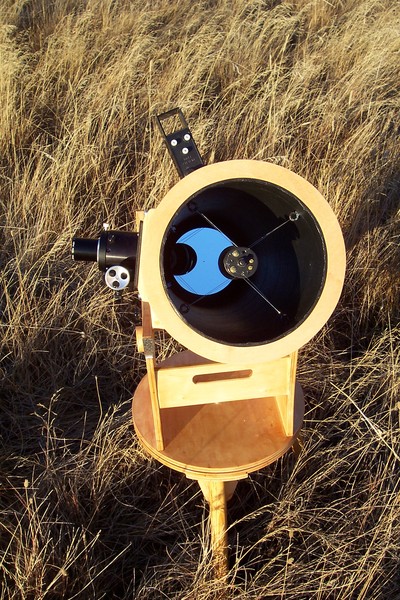
Home Telescopes Mirror Making Contact Site Map
Home --> Telescopes --> 6 inch Dob --> Wire spider
 |
If you are building your own Newtonian telescope, a great way to build your own spider is to use thin stainless steal wire instead of the traditional vanes. An offset wire spider (in which the wires are attached to the central hub a small distance away from its center) has the advantages of high stiffness and minimal diffraction.
My wire spider is in a 6 inch Dobsonian telescope with a 7 1/2 inch diameter tube, though this design could be applied to much larger telescopes. I wouldn't want to attempt this with a smaller telescope, since it would just be too hard to get my hand in there to string the wire and measure the distance between the hub and the tube. My 10 year old son is working on a 4" telescope, so we will have to decide before long whether he will be able to do it with his smaller hands.
See my list of components.
The spider is assembled as shown in the photographs. I assembled it and put it in the telescope for a dry run before gluing the mirror to it.
 |
 |
|
| The spider assembled and painted flat black. | The spider ready for a dry run in the telescope. |
Putting the spider in the telescope would be nearly impossible without some sort of jig to hold it securely in the center while you string the wires. I used the makeshift apparatus shown in the figure. Do your homework first - calculate the distance from the top of the hub to the top of the telescope. In order to do this, I made a scale drawing of the upper end of the telescope tube.
 |
| The spider attached to the jig. The mirror is wrapped in tissue paper for protection. |
You will probably want to attach one end of each wire to the hub before putting it in the telescope. Estimate how long each wire should be, and add a few inches. It is easy to clip off the excess later on. Then attach the spider to the jig, and the jig to the telescope.
Next it is time to string the wire. Once you string the wire through the last hole, secure it with the #4 machine screws, pulling the wire with pliers to get it somewhat tight. Don't worry about getting it really tight; that is accomplished by tightening the eye bolts attached to the tube. When you tighten the eye bolts, listen to the sound when you pluck the wires. They should have a medium-pitch twang, and should all produce approximately the same pitch. This is sufficient to hold the hub securely in position.
Before gluing on the diagonal mirror, it's a good idea do a dry run, putting the spider in the telescope without the mirror attached. This will allow you to verify that you measured everything correctly, and that the focuser can be aligned correctly with the mirror (I did this first with a "dummy" mirror made of wood the same thickness as the real mirror).
 |
| The spider has been carefully centered, and is ready for the wire to be strung. |
When you finally assemble the spider with the real mirror, it will take some time to get the diagonal properly centered (with the appropriate offset) in the tube. Center it as best you can with the jig attached, before you string and tighten the wires. While you string and tighten the wires, continue to verify that the spider is properly centered.